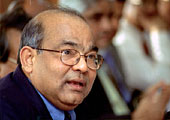 |
| Treading a tightrope: RBI Governor Y.V.
Reddy |
A
worried prime minister Manmohan Singh recently wrote to all the
chief ministers urging them to keep a check on the prices of essential
commodities and sought their personal intervention to stem the
price rise and ensure adequate supplies of essential commodities
to consumers. Clearly, inflation has become a hot potato for the
ruling establishment. Despite a slew of fiscal and monetary measures
announced by the government and RBI recently, the inflation rate
calculated on the basis of the Wholesale Price Index (WPI) has
obdurately stayed above 6 per cent levels, against the 5-5.5 per
cent inflation target set by the Reserve Bank of India (RBI) for
2006-07.
So what is stoking these figures? The Asian
Development Bank (ADB), in its latest annual report, emphasises
that agricultural stagnation is a key structural challenge in
India and rising food prices have been significant contributors
to inflation. It adds that two years of above-trend growth in
manufacturing and construction has resulted in massive demand
for credit, making it difficult to control money supply.
|
FIGHTING INFLATION
The government and RBI have moved on
several fronts to tackle inflation.
|
|
»
Government permits zero duty import of wheat
and pulses; exports also banned
» Ban
of futures trading in tur, urad, rice and wheat
» Ban
on milk powder exports
» Prices
of petrol and diesel lowered on the back of softening global
prices
» Import
duties on cooking oils, steel, aluminium, copper, cement
and chemicals cut
» RBI
hikes repo and reverse repo rates twice, by 175 and 125
basis points, since September 2004
» RBI
hikes CRR thrice in four months (in December 2006, February
and March 2007) by 50 basis points each
|
In food production, supply side bottlenecks
persist, impacting prices. Foodgrain production in India has stagnated
over the last several years even as consumption has gone up. Last
year, for instance, a shortage of pulses resulted in prices soaring
almost 30 per cent. Wheat prices have also soared 50 per cent
on the back of a domestic supply crunch. Points out Surjit Bhalla,
MD, Oxus Research: "Last year, even as stocks of wheat went
down, there was a drought in wheat producing nations like Australia,
Canada, the us and China. So, international prices of wheat went
up almost 20-25 per cent."
There may be some relief round the corner,
but the rain gods will have to oblige. Says Subir Gokarn, Chief
Economist, Crisil: "While the rabi wheat crop is expected
to be good, prices will depend on the quality of the harvest.
Pulses will be sown only in June and July. Our outlook is that
inflation will moderate if the monsoons are normal." But,
cautions R. Seshasayee, President, CII: "The agriculture
sector needs a complete overhaul. Demand-supply mismatches will
be perpetuated if we do not address the situation."
Meanwhile, a cornered government, under pressure
from allies, particularly the Left, is busy firefighting and has
resorted to drastic measures to rein in farm prices. It has banned
futures trading in rice and wheat following an earlier ban on
futures trading in tur and urad. Besides, petrol and diesel prices
have been lowered twice on the back of softening international
prices; wheat exports were banned in February; private traders
were allowed to import wheat at zero duty and customs duty on
pulses imports has been slashed to zero.
Some economists, however, feel the government
is losing sight of the bigger picture. Says Bhalla: "Last
year, inflation was stoked by high international prices of wheat
and oil. The latter has a high weightage in the inflation basket.
Since those conditions don't exist now you'll find the WPI inflation
rate gradually stabilising."
 |
"RBI is right.
Even if it slows growth, it is preferable to high growth with
high inflation"
Bimal Jalan
Former Governor, RBI |
Meanwhile, manufacturing inflation, too, is
at a high of almost 6.5 per cent. Says Bimal Jalan, former Governor,
RBI: "Manufacturing inflation is clearly a case of overheating.
Rapid production increases in the last three years have led to
capacity constraints. This is unavoidable." Inflation is
particularly high in those industries where input costs have risen
sharply. Like basic metals, alloys and metal products that depend
on imported base metals like nickel and zinc, are also feeling
the pinch. Says Marut Sen Gupta, Head, Economic Policy, CII: "Proposals
for new investments are pending clearances with various government
departments. If that process is fast-tracked, you'll see swift
capacity additions."
The government on its part has been trying
to be proactive. It has cut import duties on cooking oils, steel,
aluminium, copper, cement and chemicals and Finance Minister P.
Chidambaram has promised more measures to check prices.
Then, the RBI has begun to tighten its monetary
policy. It has hiked the Cash Reserve Ratio (CRR) by 50 basis
points each in December and February and sucked out an estimated
Rs 27,500 crore from the banking system. There's more: the central
bank has announced a third CRR hike of 50 basis points, along
with an immediate 25 basis points increase in the repo rate in
April. This will take the CRR to 6.5 per cent and drain the banking
system of another Rs 15,500 crore. Says Jalan: "The RBI is
on the right track. Even if it slows growth marginally, it is
preferable to high growth with high inflation as the latter benefits
no one."
Experts believe that the RBI move is likely
to arrest inflation and bring it down to below 6 per cent possibly
with slightly lower rates of growth. ADB estimates that the India
economy is poised for a "soft landing" with growth rates
of 8 per cent and inflation at 5 per cent. Most people-industrialists,
executives, economists and the Congress' aam aadmi-will take that.
|






